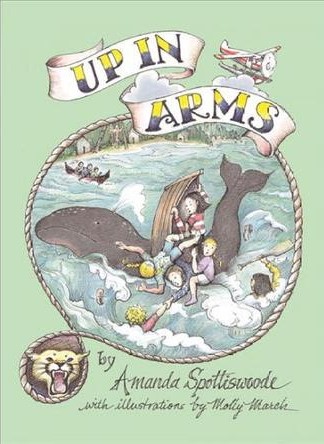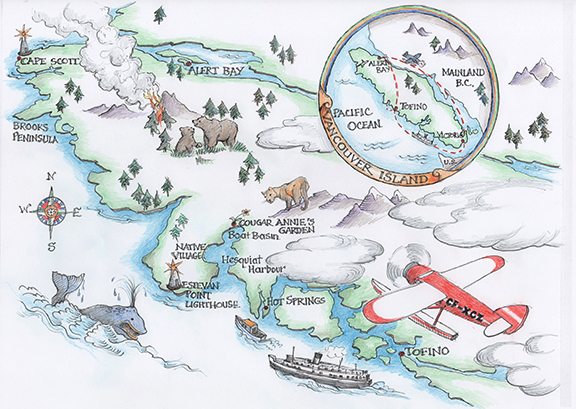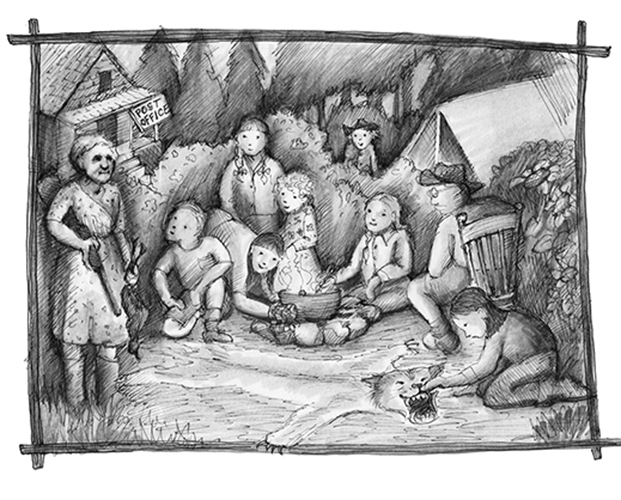| ________________
CM . . .
. Volume XXIV Number 28. . . .March 23, 2018

 |
Up in Arms.
Amanda Spottiswoode. Illustrated by Molly March.
Victoria, BC: Heritage House, 2017.
174 pp., trade pbk. & ebook., $12.95 (pbk.), $9.99 (ebook).
ISBN 978-1-77203-202-4 (pbk.), ISBN 978-1-77203-203-1 (ebook).
Grades 3-6 / Ages 8-11.
Review by Todd Kyle.
*** /4
|
| |
|

Excerpt:
“I wasn’t born yet when they were still going on,” chipped in Joe, “but I’ve heard about some of the big ones. They’d go on for days, and the masks and costumes and dances and songs were fantastic. I wish I’d seen them.”
“Why don’t they happen anymore?” asked Sophie.
Eddie paused before answering and looked around him as if he could conjure up a great potlatch from the dusty and dim corners of the longhouse.
“That,” he said, “is a very good question. The last potlatch here was almost twenty years ago when we were raided by the police and the Indian agent. They were illegal, see, and we had broken the law by holding one.”
In this third adventure about the Phillips and MacTavish children and the MacTavish’s uncle Bert, aka Captain Gunn, the children once again travel to Canada, this time to avoid danger in the United Kingdom as World War II intensifies. During their school break, the group spends time at the home of Cougar Annie while the captain is doing top secret work for the Canadian war effort. Rescued from a dangerous boat ride by Indigenous boys from the nearby reservation, they are angered when they learn of the ban on the potlatch and the subsequent confiscation of the community’s sacred masks. Spotting one of the masks at the home of the local RCMP commander, the kids steal the artifact and enlist the captain and his pilot friend to return it to its rightful owners. Returning from their clandestine affair to Victoria, the pilot suffers an asthma attack, and it falls to novice pilot Sophie to land the plane.
 As with the previous books, Up in Arms is filled with intricate details of the geography of the West Coast of Canada and of the skills of boating, with a special emphasis on aircraft piloting, especially float planes. The text flows well and keeps the reader’s interest as the kids (most of them now teens) develop their characters and pursue their interests and dreams. But the most interesting aspect here is the spotlight on Indigenous nations, their historical mistreatment, and the feelings of non Indigenous Canadians towards them. The description of the loss of the potlatch, the condescending attitude of the local priest and his housekeeper, and the dismissive stance of the police are well-illuminated, making this a timely work in today’s era of reconciliation.
As with the previous books, Up in Arms is filled with intricate details of the geography of the West Coast of Canada and of the skills of boating, with a special emphasis on aircraft piloting, especially float planes. The text flows well and keeps the reader’s interest as the kids (most of them now teens) develop their characters and pursue their interests and dreams. But the most interesting aspect here is the spotlight on Indigenous nations, their historical mistreatment, and the feelings of non Indigenous Canadians towards them. The description of the loss of the potlatch, the condescending attitude of the local priest and his housekeeper, and the dismissive stance of the police are well-illuminated, making this a timely work in today’s era of reconciliation.
As with the rest of the series, however, it is to some degree overdone. The young characters and the captain are incensed by the loss of Indigenous tradition in a way that few white Canadians were at that time. The characters frequently use the word “Indigenous” to describe the native peoples, a habit that is more of our century than theirs (it is even capitalized in the text). The prodigy of the characters is not limited to this issue, either. The youngest, Posy, is queasy at the sight of a cougar being killed when it invades Annie’s goat pen, but she consoles herself with thoughts about the “delicate and sometimes painful relationship between humans and animals”. The children are all incredibly accomplished (e.g. Sophie’s earning of her pilot’s license) and resourceful almost beyond belief. The adults, too, seem prescient beyond their years—Mrs MacTavish is described as being motivated to send the kids to Canada partly out of her fear, having heard about the treatment of Jews in Germany, that her kids are in special danger, being one quarter Jewish.
 While occasionally seeming to take ever greater pains to seem sensitive and on the right side of history, the book does illuminate the historical context by doing so. In one scene, Molly rages to the captain that having the potlatch banned is for the Indigenous what having Sunday sing alongs made illegal would be like for her family—except much worse. And in an unusually subtle move, the group is greeted by the sight of a residential school when they visit the community where the mask belongs; the school’s significance is only hinted at.
While occasionally seeming to take ever greater pains to seem sensitive and on the right side of history, the book does illuminate the historical context by doing so. In one scene, Molly rages to the captain that having the potlatch banned is for the Indigenous what having Sunday sing alongs made illegal would be like for her family—except much worse. And in an unusually subtle move, the group is greeted by the sight of a residential school when they visit the community where the mask belongs; the school’s significance is only hinted at.
The mask heist is better developed as the primary plot device than the plots in the other installments of the series, although there is still a lack of satisfaction in its conclusion. The reader may wonder why no consequences catch up to the group, not to mention why Captain Gunn, however reluctantly, agrees to participate if he is working for the Canadian government. Still, the slice of Canadian/British history set in the rich geography of B.C. and the incredible and largely sympathetic cast of characters continue to make this series both highly enjoyable and a great learning experience.
Recommended.
Todd Kyle is the CEO of the Newmarket Public Library in Ontario.

To comment on this title or this review, send mail to cm@umanitoba.ca.
© CM Association
CC BY-NC-ND
Hosted by:
University of Manitoba
ISSN 1201-9364
|
This Creative Commons license allows you to download the review and share it with others as long as you credit the CM Association. You cannot change the review in any way or use it commercially.
Commercial use is available through a contract with the CM Association. This Creative Commons license allows publishers whose works are being reviewed to download and share said CM reviews provided you credit the CM Association. |
Next Review | Table of Contents for This Issue - March 23, 2018.
CM Home | Back Issues | Search | CM Archive | Profiles Archive
|

 As with the previous books, Up in Arms is filled with intricate details of the geography of the West Coast of Canada and of the skills of boating, with a special emphasis on aircraft piloting, especially float planes. The text flows well and keeps the reader’s interest as the kids (most of them now teens) develop their characters and pursue their interests and dreams. But the most interesting aspect here is the spotlight on Indigenous nations, their historical mistreatment, and the feelings of non Indigenous Canadians towards them. The description of the loss of the potlatch, the condescending attitude of the local priest and his housekeeper, and the dismissive stance of the police are well-illuminated, making this a timely work in today’s era of reconciliation.
As with the previous books, Up in Arms is filled with intricate details of the geography of the West Coast of Canada and of the skills of boating, with a special emphasis on aircraft piloting, especially float planes. The text flows well and keeps the reader’s interest as the kids (most of them now teens) develop their characters and pursue their interests and dreams. But the most interesting aspect here is the spotlight on Indigenous nations, their historical mistreatment, and the feelings of non Indigenous Canadians towards them. The description of the loss of the potlatch, the condescending attitude of the local priest and his housekeeper, and the dismissive stance of the police are well-illuminated, making this a timely work in today’s era of reconciliation. While occasionally seeming to take ever greater pains to seem sensitive and on the right side of history, the book does illuminate the historical context by doing so. In one scene, Molly rages to the captain that having the potlatch banned is for the Indigenous what having Sunday sing alongs made illegal would be like for her family—except much worse. And in an unusually subtle move, the group is greeted by the sight of a residential school when they visit the community where the mask belongs; the school’s significance is only hinted at.
While occasionally seeming to take ever greater pains to seem sensitive and on the right side of history, the book does illuminate the historical context by doing so. In one scene, Molly rages to the captain that having the potlatch banned is for the Indigenous what having Sunday sing alongs made illegal would be like for her family—except much worse. And in an unusually subtle move, the group is greeted by the sight of a residential school when they visit the community where the mask belongs; the school’s significance is only hinted at.